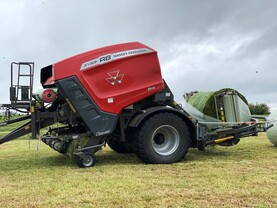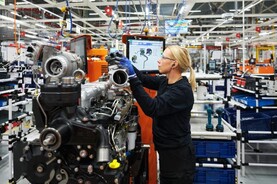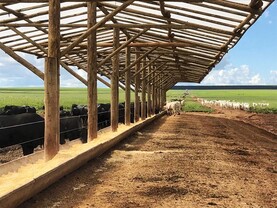It would be fair to say that the Finns haven’t rushed into this one. The development of the Valtra T4 series started in 2008. The project involved huge market research and over 40,000 hours of testing all over the world. Valtra claims to have used one million litres of fuel in testing. “Your working machine” is the message that Valtra pushed as its new brand identity dedicated to the customer.
The T4 is the first new product from Valtra in 25 years. The company is proud of the styling and improvements. The T4 has been designed to give it a more universal appeal to all drivers, yet it still maintains some of the traditional Valtra values that are favorites with existing customers. This tractor has the looks and the muscle to become a serious challenger on the market.
The existing T-series models have outlived most other manufacturers’ models, but the need for modernisation was evident. Valtra, through its customer-focused research, designed the tractor prioritising the most important points raised.
Over 99% of those surveyed gave reliability, performance and durability as their key demands in a tractor. Valtra claims that this tractor will have no problems delivering on those demands.
The new T4 is available in four model specifications. – Direct, Versu, Active and Hi-Tech. The Direct models are top of the range, with a continuously variable transmission and electrically-operated hydraulics. While Versu and Active models share the same powershift transmission, the Versu models have electrically-operated hydraulics and an integrated display terminal in the armrest. The lower spec Active has mechanically-operated hydraulics and no display terminal. The HiTech model is not available until next year.
New cab
Valtra claims that this cab is now the biggest in its tractor class. It offers 6.2m2 of glass and 2.6m2 of interior space. The front wiper can travel 270 degrees to keep all of the glass clean. The impression when in the driving seat is that the cab has a bright, airy feel. The cabin is 20cm wider at the hip area than the cab on the older T-series. It was displayed to us by a rather well-built man who had ample space in the driving position.
The extra width provided by the curved pillars in the cab allows for a decent passenger seat to be fitted. The cab is a five-post design, with one fully functioning door. According to Valtra, the five-post design is better because the door is easier to close and less cumbersome than larger makes.
The controls in the cab are still familiar. The rally-like steering wheel and forward reverse selector remain the same. The dash itself has been upgraded, presenting clearer display dials. Depending on the model, the armrest option is matched with or without the integrated terminal.
The controls on the right armrest are similar to previous versions except the throttle is back on top. An optional C3000 touchscreen can be fitted for operators requiring guidance and telematics options.
Twin Trac reverse drive machines
The novel Twin Trac reverse drive machines are still available. The big change, because of fly-by-wire connection, is the ability to move the reverse steering from side to side and have its reach and rake adjusted.
The seat and armrest controls move around easily and give the driver a comfortable position when operating in reverse. These model tractors come with quick steer as standard, which allows the operator to turn up to 60% faster, according to Valtra. For safety, the quick steer system in reverse or normal driving mode will automatically disengage at a speed of 20km/h.
The powershift revolution
According to Valtra, what the customer wants is a powershift transmission that drives like a CVT. Valtra has tried to deliver here with good results. From driving the tractor at the launch in Germany with a Valtra engineer, the hill-hold feature works.
Clever integration with the electronic parking brake allows this to happen. When you want to stop on a hill, keep your foot on the brakes and at the same time move the shuttle into its park position. Then move the shuttle back to the forward position. Take your foot off the brakes and the tractor will hold itself in position. Press the accelerator and the brake releases and the tractor moves on again.
A new speed control lever on the armrest facilitates a change in speed. Push forward to go faster and pull back to go slower. Buttons incorporated into the side of the lever allow for range changes, but an automatic range change can occur between ranges C and D and vice versa, if enabled. By changing the lever over to one side, the accelerator pedal becomes the speed selector, with the tractor working out the optimum revs and ratios for the desired speed.
Pedal mode can also be used for PTO work, with the RPM staying at a constant speed and the pedal used to adjust the forward speed like a CVT. Two cruise speeds can also be set, simply by driving at a desired speed and pressing and holding one of two buttons to save.
Speed can also be adjusted by a scroll wheel beside the speed control lever. Cruise speeds can be incorporated into a headland management sequence. The powershift transmission on the T4 has enabled the driver to operate it like an automatic car. The clutch is only a safety device for starting.
Engine
Power comes from an Agco Power, 6.6-litre, six-cylinder engine for the two smallest models and a 7.4-litre version for the larger models. Both engines comply with Stage 4 emissions legislation. Agco manufactures approximately 70,000 engines per year. The main components of this engine are the same as the original design seen in the 1990s. Valtra claims that the average lifespan of its engines is 25,000 hours.
According to Valtra, selective catalytic reduction only is used. While this takes care of the nitrous oxide, high-pressure fuel injection reduces the amount of particles being produced. This eliminates the need for exhaust gas recirculation or a diesel particulate filter.
The design reduces the amount of service items and allows service intervals to be extended by 600 hours for the engine.
The T174 model is also available with the firm’s Eco Power feature, allowing the nominal engine speed to be reduced to 1,800rpm and the torque increased at the push of a button, where jobs allow.
In addition, the Sigma Power feature, which is standard or available on all models, increases engine output by 15hp when the PTO is under sufficient load or when the tractor is at either of the top two transmission ranges. A three-piece bonnet allows convenient service access to engine, with all serviceable items positioned on one side. Hydraulic and transmission oil levels can easily be checked via sight glasses.
Hydraulics and linkage
Rear linkage lift capacity has been up-rated to 9.5t, while the integrated linkage can handle 5.1t at the front.
Whether it is fitted with a loader or front linkage, turning the radius is tight thanks to the repositioning of the engine and front axle. This has seen the engine move backwards and the front axle move forwards with the cooling packs placed over the top of the axle, allowing the front wheels to turn into recessed areas on the bonnet. A longer wheelbase means extra stability, taking the bounce out of the Valtra on the road and increased traction in the field. The Finnish manufacturer believes that farms are increasing in size and expects that a tractor will have 15 % more road usage in the future.
Three PTO speeds in five modes can now be electrically selected; 1,000, 1,000E, 540, 540E and ground speed. The rear of the tractor has been designed, to be a lot friendlier with spool valves repositioned on the left side. The electric controls are placed lower on the mudguard, making it more accessible.
See page 6 of the Focus supplement for prices of
all Valtra models. It looks like Valtra has put effort and thought into this tractor. It is perhaps now an option for farmers who never really looked at the brand before.
We like the:
v New tractor and cab design, which has increased by 20cm in width.
v Longer wheelbase, up from 2.7m to 2.995m.
v 55o turning angle, giving a 5.25 turning radius.
v Smooth engines.
v Quality build.
v Extended 600-hour service.
We dislike:
X Chunky exhaust.
X One-door entry.
X Awkward emergency hydraulic oil filler under
the tractor steps.
It would be fair to say that the Finns haven’t rushed into this one. The development of the Valtra T4 series started in 2008. The project involved huge market research and over 40,000 hours of testing all over the world. Valtra claims to have used one million litres of fuel in testing. “Your working machine” is the message that Valtra pushed as its new brand identity dedicated to the customer.
The T4 is the first new product from Valtra in 25 years. The company is proud of the styling and improvements. The T4 has been designed to give it a more universal appeal to all drivers, yet it still maintains some of the traditional Valtra values that are favorites with existing customers. This tractor has the looks and the muscle to become a serious challenger on the market.
The existing T-series models have outlived most other manufacturers’ models, but the need for modernisation was evident. Valtra, through its customer-focused research, designed the tractor prioritising the most important points raised.
Over 99% of those surveyed gave reliability, performance and durability as their key demands in a tractor. Valtra claims that this tractor will have no problems delivering on those demands.
The new T4 is available in four model specifications. – Direct, Versu, Active and Hi-Tech. The Direct models are top of the range, with a continuously variable transmission and electrically-operated hydraulics. While Versu and Active models share the same powershift transmission, the Versu models have electrically-operated hydraulics and an integrated display terminal in the armrest. The lower spec Active has mechanically-operated hydraulics and no display terminal. The HiTech model is not available until next year.
New cab
Valtra claims that this cab is now the biggest in its tractor class. It offers 6.2m2 of glass and 2.6m2 of interior space. The front wiper can travel 270 degrees to keep all of the glass clean. The impression when in the driving seat is that the cab has a bright, airy feel. The cabin is 20cm wider at the hip area than the cab on the older T-series. It was displayed to us by a rather well-built man who had ample space in the driving position.
The extra width provided by the curved pillars in the cab allows for a decent passenger seat to be fitted. The cab is a five-post design, with one fully functioning door. According to Valtra, the five-post design is better because the door is easier to close and less cumbersome than larger makes.
The controls in the cab are still familiar. The rally-like steering wheel and forward reverse selector remain the same. The dash itself has been upgraded, presenting clearer display dials. Depending on the model, the armrest option is matched with or without the integrated terminal.
The controls on the right armrest are similar to previous versions except the throttle is back on top. An optional C3000 touchscreen can be fitted for operators requiring guidance and telematics options.
Twin Trac reverse drive machines
The novel Twin Trac reverse drive machines are still available. The big change, because of fly-by-wire connection, is the ability to move the reverse steering from side to side and have its reach and rake adjusted.
The seat and armrest controls move around easily and give the driver a comfortable position when operating in reverse. These model tractors come with quick steer as standard, which allows the operator to turn up to 60% faster, according to Valtra. For safety, the quick steer system in reverse or normal driving mode will automatically disengage at a speed of 20km/h.
The powershift revolution
According to Valtra, what the customer wants is a powershift transmission that drives like a CVT. Valtra has tried to deliver here with good results. From driving the tractor at the launch in Germany with a Valtra engineer, the hill-hold feature works.
Clever integration with the electronic parking brake allows this to happen. When you want to stop on a hill, keep your foot on the brakes and at the same time move the shuttle into its park position. Then move the shuttle back to the forward position. Take your foot off the brakes and the tractor will hold itself in position. Press the accelerator and the brake releases and the tractor moves on again.
A new speed control lever on the armrest facilitates a change in speed. Push forward to go faster and pull back to go slower. Buttons incorporated into the side of the lever allow for range changes, but an automatic range change can occur between ranges C and D and vice versa, if enabled. By changing the lever over to one side, the accelerator pedal becomes the speed selector, with the tractor working out the optimum revs and ratios for the desired speed.
Pedal mode can also be used for PTO work, with the RPM staying at a constant speed and the pedal used to adjust the forward speed like a CVT. Two cruise speeds can also be set, simply by driving at a desired speed and pressing and holding one of two buttons to save.
Speed can also be adjusted by a scroll wheel beside the speed control lever. Cruise speeds can be incorporated into a headland management sequence. The powershift transmission on the T4 has enabled the driver to operate it like an automatic car. The clutch is only a safety device for starting.
Engine
Power comes from an Agco Power, 6.6-litre, six-cylinder engine for the two smallest models and a 7.4-litre version for the larger models. Both engines comply with Stage 4 emissions legislation. Agco manufactures approximately 70,000 engines per year. The main components of this engine are the same as the original design seen in the 1990s. Valtra claims that the average lifespan of its engines is 25,000 hours.
According to Valtra, selective catalytic reduction only is used. While this takes care of the nitrous oxide, high-pressure fuel injection reduces the amount of particles being produced. This eliminates the need for exhaust gas recirculation or a diesel particulate filter.
The design reduces the amount of service items and allows service intervals to be extended by 600 hours for the engine.
The T174 model is also available with the firm’s Eco Power feature, allowing the nominal engine speed to be reduced to 1,800rpm and the torque increased at the push of a button, where jobs allow.
In addition, the Sigma Power feature, which is standard or available on all models, increases engine output by 15hp when the PTO is under sufficient load or when the tractor is at either of the top two transmission ranges. A three-piece bonnet allows convenient service access to engine, with all serviceable items positioned on one side. Hydraulic and transmission oil levels can easily be checked via sight glasses.
Hydraulics and linkage
Rear linkage lift capacity has been up-rated to 9.5t, while the integrated linkage can handle 5.1t at the front.
Whether it is fitted with a loader or front linkage, turning the radius is tight thanks to the repositioning of the engine and front axle. This has seen the engine move backwards and the front axle move forwards with the cooling packs placed over the top of the axle, allowing the front wheels to turn into recessed areas on the bonnet. A longer wheelbase means extra stability, taking the bounce out of the Valtra on the road and increased traction in the field. The Finnish manufacturer believes that farms are increasing in size and expects that a tractor will have 15 % more road usage in the future.
Three PTO speeds in five modes can now be electrically selected; 1,000, 1,000E, 540, 540E and ground speed. The rear of the tractor has been designed, to be a lot friendlier with spool valves repositioned on the left side. The electric controls are placed lower on the mudguard, making it more accessible.
See page 6 of the Focus supplement for prices of
all Valtra models. It looks like Valtra has put effort and thought into this tractor. It is perhaps now an option for farmers who never really looked at the brand before.
We like the:
v New tractor and cab design, which has increased by 20cm in width.
v Longer wheelbase, up from 2.7m to 2.995m.
v 55o turning angle, giving a 5.25 turning radius.
v Smooth engines.
v Quality build.
v Extended 600-hour service.
We dislike:
X Chunky exhaust.
X One-door entry.
X Awkward emergency hydraulic oil filler under
the tractor steps.






 This is a subscriber-only article
This is a subscriber-only article

















SHARING OPTIONS: